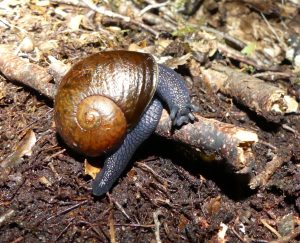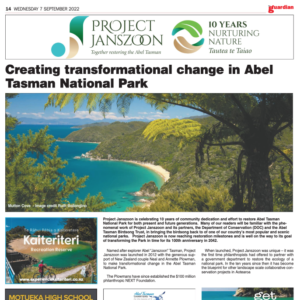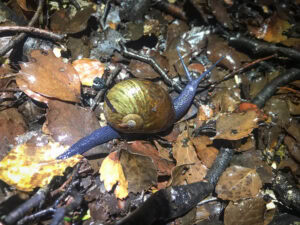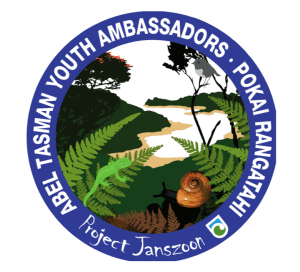
Native giant snail Rhytida oconneri – Philip Simpson
Project Janszoon is building two fenced snail sanctuaries in the Abel Tasman National Park, to investigate whether protection from weka will help two at-risk land snail populations survive.
For the last seven years, Project Janszoon scientific advisor Ruth Bollongino has been working with a group of volunteers to monitor Powelliphanta hochstetteri and Rhytida oconneri snail opulations in the Canaan and Wainui areas. Rhytida oconneri is of particular importance as it is only found on Takaka Hill and a few places in Golden Bay.
The monitoring project has involved overnight forays on warm, damp summer nights when the nocturnal snails are active, to count and mark snails and then record their re-capture on subsequent visits to the same locations.
The project aimed to see how snail populations were faring and what threats were likely to impact their survival.
Ruth says that while initial thoughts were that population declines were due to rats eating the snails, further research and shell studies suggest that weka are more likely to be the culprit.
“We are pretty sure that both snail species are facing local extinction within the next year due to increases in weka number in the area,” says Ruth.
To protect the remaining snails and investigate whether weka really are the main predator, Project Janszoon is constructing two fenced enclosures 70 x 70m in size in areas where snails are known to be hanging on. The locations being considered include Upper Wainui, Pisgah and Canaan Downs.
The enclosures will be constructed from waratahs, sheep netting and chicken netting with a mesh size small enough to keep weka and pigs out and keep mature snails with a shell size above 50mm in.
“We expect young snails to wander out of the enclosure but if we can keep the adults in we will have a secure breeding population of both species. Without this intervention they are unlikely to survive much longer in these locations,” says Ruth.
Powelliphanta snails are among the largest snails in the world and are among our most threatened invertebrates. Powelliphanta hochstetteri and Rhytida oconneri are carnivorous, nocturnal species – P. hochstetteri can grow up to 78 mm in diameter and can live 20 years or more. Although less iconic than kiwi, these unique molluscs are equally special and unique and are also endemic to NZ . Their carnivorous diet includes worms (which they suck in like spaghetti) and slugs.
They fall victim to the hungry appetites of rats, possums and pigs as well as weka. They are also impacted by habitat loss due to human activities such as mining and forest clearing, and by browsing pests such as deer and goats which destroy the natural understorey and upset the delicate leaf litter balance in our native forests.
Our native land snails are also being affected by climate change. A recent drought event left snails hungry and their growth rates came to a halt, resulting in high mortality rates in juvenile snails.
Weka are natural predators of snails but with all the other man-made pressures on these delicately balanced populations, they can no longer tolerate weka predation and survive.
The snail enclosures are expected to be erected over the coming months, and the study findings will be published once completed.



